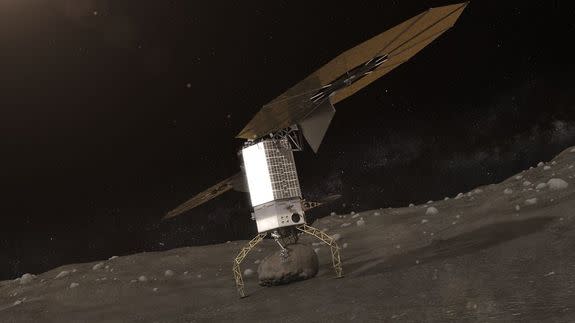The Evolution of NASA's Ambitious Asteroid-Capture Mission

NASA's ambitious asteroid-capture mission has changed a lot since the agency officially announced its existence less than two years ago.
The original plan, which was revealed in April 2013, called for dragging an intact small space rock into orbit around the moon, where it would be visited by astronauts, perhaps as early as 2021. But NASA officials announced last Wednesday (March 25) that the mission will instead pluck a boulder off a much larger asteroid, and that the manned inspection in lunar orbit will likely come in 2025.
Here's a quick look at the evolution of NASA's Asteroid Redirect Mission, from Point A to "Option B" (as the boulder-grabbing idea is known). [NASA's Asteroid Capture Mission in Pictures]
A presidential directive
The ultimate goal of NASA's human spaceflight program has long been putting boots on Mars. During the 2000s, NASA viewed the moon as the primary stepping stone to the Red Planet, and worked to get astronauts to Earth's nearest neighbor under a program known as Constellation.
But in 2010, President Barack Obama cancelled Constellation after a review panel determined that the program was considerably overbudget and behind schedule. That same year, Obama issued a directive to NASA: Get astronauts to a near-Earth asteroid by 2025, then on to the vicinity of Mars by the mid-2030s.
Initial planning efforts envisioned sending people out to rendezvous with a space rock in its native orbit. But that began to change in 2012, with the publication of a study by researchers based at the Keck Institute of Space Sciences at the California Institute of Technology in Pasadena.
The Keck paper investigated the feasibility of using a robotic spacecraft to capture a small (roughly 23-foot-wide, or 7 meters) asteroid and tow it back to high lunar orbit for future inspection. This could probably be done for about $2.6 billion, the study's authors concluded.
NASA officials, intrigued by the possibility of meeting Obama's requirement without breaking the bank, soon commissioned their own study of the Keck idea. The results were encouraging, and the agency unveiled the Asteroid Redirect Mission (ARM) on April 10, 2013 with the release of the fiscal year 2014 federal budget request.
Bag or pluck?
At first, ARM imagined capturing an entire asteroid in a big bag, as this NASA animation illustrates. But as 2013 progressed, engineers began studying an alternative approach — sending the robotic probe out to a much larger asteroid, one at least 330 feet (100 m) wide, and grabbing a boulder from its surface.
This Option B offered a number of potential advantages, advocates said. For example, most big space rocks harbor lots of boulders, so odds are good that a capture craft that visits one would be able to find an appropriate sample.
It's tough to gauge the size of small asteroids precisely from afar, by contrast, making "Option A" riskier in certain respects: What if the robotic probe reached its destination after two years of spaceflight and found it too large to bag up?
Option B would also target an asteroid big enough to do serious damage to Earth, opening up opportunities to do some planetary protection research, its backers said. Indeed, Option B's designers suggested that the spacecraft should fly along with the asteroid for a while after it plucked the boulder, in a demonstration of the "enhanced gravity tractor" strategy of space-rock deflection. [Potentially Dangerous Asteroids (Images)]
Gravity tractors are probes that nudge an asteroid off course slightly, via the exertion of a tiny but persistent gravitational tug. The ARM version would be "enhanced" by the mass of the boulder.
Going with Option B
NASA studied the pros and cons of Option A and Option B for more than a year before deciding to go with the latter, even though it will cost about $100 million more. (ARM's total cost, not including the launch vehicle or human visits down the road, will be capped at $1.25 billion. The mission will be cheaper than the Keck study estimated because it will take advantage of pre-existing and ongoing technology development, NASA officials have said.)
NASA Associate Administrator Robert Lightfoot said the decision was based on a number of factors, inclduing the reduced risks inherent in Option B and the chance to do an asteroid-deflection demo.
The technologies developed for Option B should also be more "extensible," helping humanity push farther out into the solar system, Lightfoot added.
"ARM is an important part of the overall mission of taking humans further into space," he told reporters druing a news conference on March 25. The systems the Option B probe will use to soft-land on an asteroid and snag a boulder "are the kind of things we know we're going to need when we go to another planetary body. So that was really important."
The plan
Here's how ARM will work, if everything goes according to plan: The capture probe will blast off in December 2020, perhaps toward a 1,300-foot-wide (400 m) asteroid called 2008 EV5. This is the leading candidate space rock at the moment, but the target will not have to be chosen until 2019, Lightfoot said.
After about two years of spaceflight, the robotic craft will rendezvous with the asteroid, assess the available boulders, and grab one up to 13 feet (4 m) wide. The probe will stay with the asteroid for 215 to 400 days to perform the deflection demonstration, then head for lunar orbit.
The probe should get to the moon sometime in 2025. At that point, NASA will send two astronauts out to inspect the boulder, using the agency's Orion capsule and Space Launch System megarocket, both of which are in development. This manned mission will likely last 24 or 25 days.
Follow Mike Wall on Twitter @michaeldwall and Google+. Follow us @Spacedotcom, Facebook or Google+. Originally published on Space.com.
Copyright 2015 SPACE.com, a Purch company. All rights reserved. This material may not be published, broadcast, rewritten or redistributed.

 Yahoo News
Yahoo News 